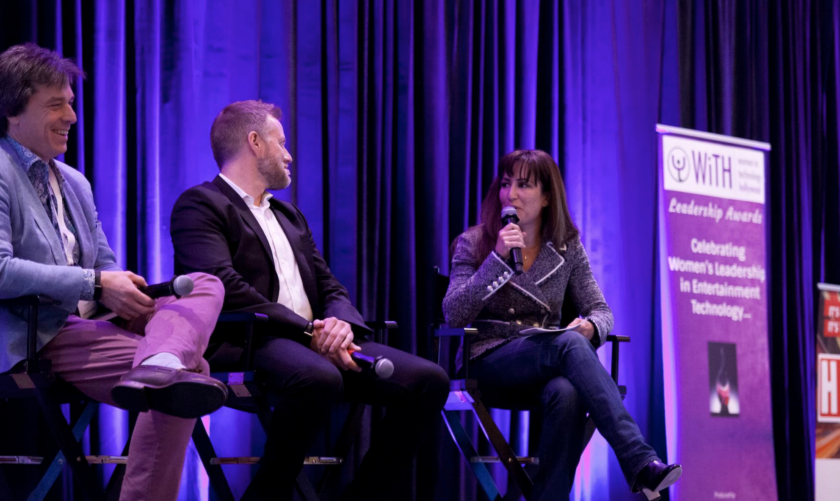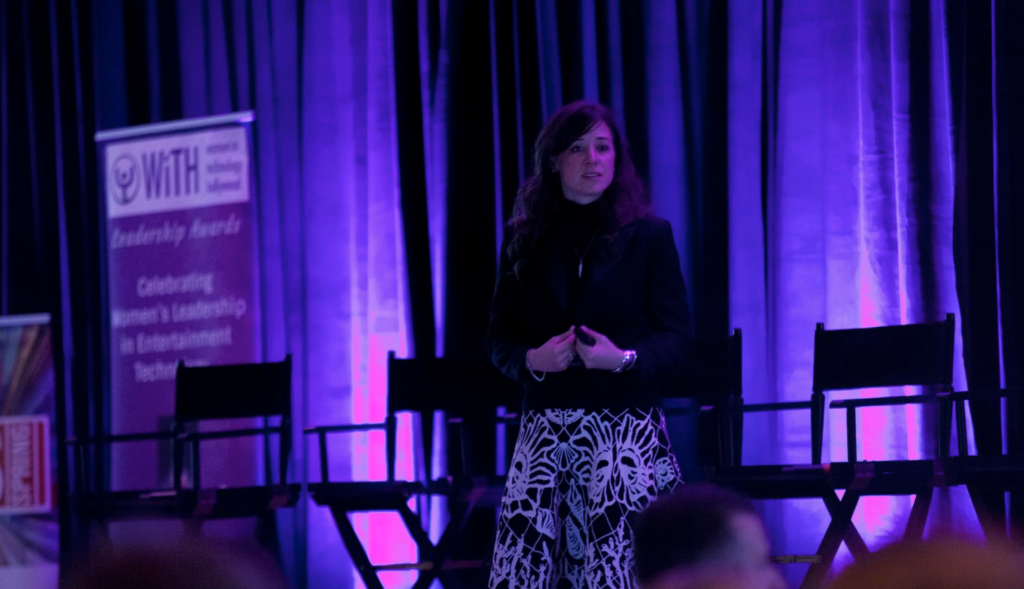
HITS Spring: Empathetic Technologies Present Major Opportunities for Entertainment Industry
Empathetic technologies can help us connect with each other and ourselves in the most human ways, and they present significant opportunities to the entertainment industry and content creation, according to Poppy Crum, chief scientist at Dolby Laboratories and adjunct professor at Stanford University’s Center for Computer Research.
These new technologies stand to “transform the relationship we have with each other and with the spaces where we work, train… and live” — and those are the spaces “where we consume our content,” she said May 23 while giving a keynote called “Connecting Technology to Emotions in Content Creation and Innovation” during the special Women in Technology: Hollywood (WiTH) program section at the annual HITS Spring event.
Content creators are beginning to adopt these technologies that can be leveraged to influence each part of the end-to-end story-telling process, as well as transform the “traditional” approach to creating content, according to Crum. The irresistible possibilities of these technology advances are profound and will lead to innovations in how we are moving ideas into reality, she said.
About two years ago, she was at the Smithsonian Institution’s Albert Einstein Planetarium with her two-and-a-half-year-old daughter, watching a documentary about the sun, she noted at the start of the session. The room was quiet, and her daughter yelled out “Minions!” because an image on screen reminded her of the little yellow creatures from Universal’s animated movies.
That was an example of the fact that, when it comes to content, “we each have vastly different experiences of the exact same physical information in the world,” she said. Therefore, “it’s not enough to just know what the physical information is” because the way we view content is shaped by several factors that include our biology, “the information we’ve been exposed to in our environments, as well as our expectations,” she noted.
The pressures we each face in our specific environments “shape who we are” and “they change our brain” also, she told attendees.
“In many ways, technology is changing,” she said, explaining: “We’ve moved past machine learning algorithms that just detect whether I’m feigning a smile or a frown to a state where an algorithm can know the authenticity of what I’m feeling – what my emotions are at a particular moment in time, tracking micro expressions [and] other types of information from my body.”
 This kind of technology can be used negatively, but she focused on the “positive opportunities that we have to think about the future and the ways we can change and interact more intimately, more richly with the content and technologies that we interact with on a daily basis,” she said.
This kind of technology can be used negatively, but she focused on the “positive opportunities that we have to think about the future and the ways we can change and interact more intimately, more richly with the content and technologies that we interact with on a daily basis,” she said.
One major change we’re seeing now is what she calls “technology-targeted neuroplasticity,” which she said will “make us faster, recover more rapidly, hear more acutely, see more sharply and think more effectively.” The human brain is “malleable” and each one is different, she said, noting that if she plays the video game “Call of Duty” for 40 hours, she sees the world differently than another person.
As a matter of fact, she explained, “every time we engage in rich environments, we walk out of them a different person, and we can start predicting that – and predicting how technology will shape us and make us more effective.”
We’re now “closing the loop between the human and the technology,” she said, adding: “Empathetic technology is not about technology empathizing with me. It’s about technology using my internal experiences as a decision driver in [it]s algorithm for how it reacts… We aren’t just defining how a technology objectively behaves or what the end goal is. Instead, we’re defining it based on how it actually interacts with the user…. What we do is build tools that enable creators to reach emotions of individuals and to create stories, and it’s our responsibility to care about every point in the pathway that those stories are translated all the way to the end user and that they experience what they should.”
Now, “between ubiquitous computing and the amalgamation of sensors in our environment, paired with machine learning” and artificial intelligence (AI)… we can know what everyone is experiencing, and we can think about what closing that loop really means,” she told attendees.
Amid “one size fits all technology,” she said, “we have to think very differently in the future.” Meanwhile, “control, insight and creation are the three things that matter to get us to this next level,” she said.
“We process color, we process change, we process emotion all differently depending on where our gaze is directed,” she noted. Therefore, she said, “as a developer, I’m in a really bad place if I don’t know where you’re looking.” She added: “There’s all sorts of things I can do if I just know one thing, and that’s where your eye is directed. Knowing that one piece of information gives me huge capacity to optimize my coding, to create a better experience, to direct what you feel – everything.”
Fifteen years ago, “pupil trackers” used to know where someone’s gaze was directed, cost her $15,000-$30,000, but “today, those are dollars and, soon, they’ll be pennies in every pair of smart glasses,” she said.
Introducing another WiTH session, “Male Allies: Motivation, Benefits, and Tangible Actions,” Davida Lara, EVP of payroll at Entertainment Partners, stressed the importance of diversity and told attendees: “There are so many more of us in this industry and coming into this space because male allies are helping us do it.”
The invitation to participate on the panel “caused me to sit back and reflect” on the fact that “security in particular at any technology organizations tend to be white male-centric unfortunately,” Ben Stanbury, content security officer at Amazon Studios, chairman of the Content Delivery & Security Association (CDSA) and CTO of the Trusted Partner Network (TPN), said.
But “I never kind of woke up one morning and decided that I really wanted to champion diversity,” he admitted, adding that instead his “motivator initially was kind of selfish.” He was thinking of ways to be a better leader, how to build robust teams and have a different perspective, he explained, adding: “It just started organically without any real conscious thought that that’s something that I wanted to be championing.”
But there’s better ways to increase diversity at an organization than to just have a human resources person force a hiring manager to make a diversity hire just for the sake of making a diversity hire, he said. “Trying to bring about a diverse workforce” by making sure that “20 percent of your team is diverse – I just don’t think that’s a constructive motivator,” he said. Instead, it’s important to give good reasons for legacy leadership to opt for more diverse employees, he explained, adding it’s not just hiring that needs to be changed. Cultural change is important at organizations also, he said.
Also important, he said: Making sure everybody on a team feels comfortable raising their hands and being heard. He also recommended that everybody – regardless of whet sex they are – build a “good network of mentors – not only within your team, within your organization – but actually outside of the company [and in] different parts of the organization.”
While it’s important for male leaders to listen to the perspectives of women on their teams, a representative of Creative Artists Agency (CAA) also pointed out that films tend to do better when there’s more diversity, and having diversity within an organization is just the right thing to do.
HITS Spring was presented by Entertainment Partners, with sponsorship by LiveTiles, 5th Kind, Amazon Web Services, Birlasoft, Exactuals, Expert System, MarkLogic, Microsoft Azure, Richey May Technology Solutions, SoftServe, Spark Digital, Avanade, CDSA, Cinelytic, EIDR, MicroStrategy, Signiant, the Trusted Partner Network, human-I-T, and Zaszou IT Consulting.
The event was produced by the Media & Entertainment Services Alliance (MESA) and the Hollywood IT Society (HITS), in association with Women in Technology: Hollywood (WiTH); CDSA; and the Smart Content Council.
